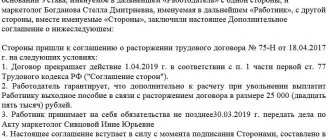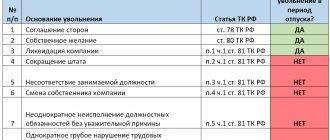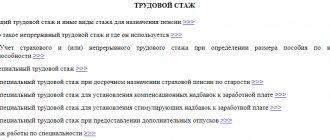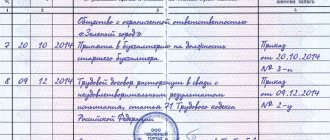Many organizations have positions that provide financial responsibility. Employees holding such positions are considered materially responsible persons (MRP). They are responsible to the employer for the safety of certain property and inventory items.
Labor relations with such employees are formalized by concluding a standard contract, as well as an additional agreement regulating financial liability. It is necessary to find out how an employment contract with MOL is terminated, what procedure for dismissal is implemented.
Law on the dismissal of a financially responsible person
Any relationship, including labor relations, is no exception; sooner or later they can be broken.
The dismissal of an employee, regardless of what obligations he has and whoever he is, must occur as required by current legislation. The general rules for dismissal from positions are described in Article 84.1 of the Labor Code of the Russian Federation.
How to calculate an official carrying a mat. responsibility? This question often worries employers. How to make an inventory of assets belonging to the enterprise, how to entrust mat. values that belong to an employee of an organization to another person? Is it possible to reduce the staffing level that is responsible for the values entrusted to it, etc. We will try to answer these and other questions today.
How does unscheduled differ from planned?
There are several parameters by which these two types of control are distinguished:
- The time frame within which documentation must be completed. If this is a planned recount, then the accompanying documentation is sent to the head of the organization for review no later than 3 business days before the start. For VI this is just a day.
- Content. When planning a calculation, it is important to study all the points that are provided for in labor legislation. With VI, only issues that fall under certain aspects of life or the structure of the enterprise are resolved.
- Punishment. If violations are discovered during a routine inspection, this is often followed by significant administrative measures. For unscheduled ones, these are usually light punishments - deprivation of bonuses, a reprimand, a warning and others like that.
- How often is it used? Scheduled recalculations are carried out no more often than once every 3 years. There are no such restrictions for VI; it can be initiated even once a month.
The procedure for transferring values
There are two generalized models for the transfer of values, and neither is standardized by law .
- The first is that a candidate for the vacant position that is being vacated has not yet been found.
- The second is that there is already another employee ready to start work the next day after the predecessor leaves the position.
Let's consider the first model. It is clear that the work related to maintaining the organization’s property cannot be entrusted to the first person who comes along. Therefore, finding a candidate may take some time. Under such conditions, it is worth looking for a replacement among the company’s employees.
ATTENTION! Valuables should not be transferred to employees with whom it is impossible to conclude a full agreement. responsibility. Such a mistake can cost the employer dearly. The legislation does not allow the employer to enter into an agreement with all employees of the enterprise.
If the agreement was signed with an employee of the organization, whose job responsibilities (work performed) are not on the list set out in the said resolution, the employer will not be able to hold him accountable and recover damages from him.
You should not transfer valuables or enter into an agreement with a person who is not officially hired for the position.
- Before dismissal, the employee transfers the valuables to the commission, which conducts an inventory.
- The room where material assets are stored (a safe with monetary values) is sealed by the commission.
- The next day, after the dismissal of the previous employee is formalized, a new one is hired and the valuables are transferred to him.
It is this kind of procedure that is provided for by the legislation of the Russian Federation.
You can learn more about changing a materially responsible employee and transferring his responsibilities to another here.
Peculiarities
Before the start, all financially responsible employees whose departments will participate in the recount prepare receipts. They must state that on the day of the VI, all reports have been drawn up and are ready for verification. Then they create an order that specifies:
- composition of the commission;
- time frame;
- scene.
As we have already said, the document is registered in a special book for control. It becomes the basis according to which all actions are carried out.
Not only the heads of the company can declare the need, but also:
- investigators;
- courts - in accordance with the resolution;
- head office - if it is a subsidiary or branch.
Who is on the inventory committee?
These are permanent members of the meeting or hired people from other firms specializing in auditing.
If the management does not have any suspicions or facts of theft, then employees from the administration and accounting department are invited to act as inspectors. It is easier for them to then correlate the received data with information from the database; the analysis will be completed several times faster. It is allowed to involve financially responsible persons from the department being audited, but this is not always done.
The final composition is approved by the head of the organization. Before starting, a meeting must be organized for the members of the future commission. There the goals and objectives to be achieved are identified, and the rules for implementation are discussed.
Timing of unscheduled inventory
Before the procedure begins, the accounting department must prepare a lot of documents - matching statements, various interim acts and inventories.
Dates and times are not disclosed; employees will learn about them directly two days before the event. Depending on the size of the enterprise, it can last from 1 to 20 working days. At this time, the workshop, structural unit or the entire organization does not work - it does not accept or ship products, does not produce them. Processes can be resumed only after completion and completion of matching sheets. This is necessary so that in the event of a repeated recalculation, the discrepancy can be quickly found and studied.
Inventory check location
Depends on its variety. If it is documentary, then it is performed directly in the accountant’s office. With natural production, first the commission members recalculate the actual number of products, and then compare them with the data in the program.
It is important that appropriate software is installed that allows you to synchronize balances in the warehouse and in the accounting department. Then the likelihood of making an error will be lower, but it cannot be completely eliminated due to the human factor and the likelihood of equipment failure. Such programs help calculate the actual quantities of goods and finished products, raw materials and fixed assets.
Cleverence specialists can help with the selection of such software. We'll work with you to define your goals and then select the right software to streamline your operations and make your work easier.
How to leave a position of your own free will?
Now, in more detail about the procedure for dismissing a financially responsible person at his own request. To resign from a position on your own initiative, you must follow this procedure:
- the employee must notify the employer in writing at least 14 days in advance (unless there is a valid reason for exemption from work);
- further, the commission, in the presence of the financially responsible employee leaving his post, must take swear words from him. valuables and take inventory. If a deficiency or damage to property is identified, a report is drawn up;
- the employer, in turn, must draw up a dismissal order;
- on the last working day, the employee is given a work certificate against signature and the final payment is made to him.
Even if a shortage is identified, the employer does not have the right not to give the employee the work permit. If the employee does not agree to pay the shortfall, the employer has the right to go to court.
An employer cannot help but fire an employee of his organization until he has transferred valuables. The procedure for dismissing a financially responsible employee certainly has its own characteristics, but the grounds and execution of personnel documents are standard, as for all other employees. And it doesn’t matter who initiates the dismissal: the employee or the employer.
EXAMPLE:
The employee submitted a letter of resignation of his own free will. After the two weeks required in this case, the employer must pay the employee off. The position “I’ll fire you when you hand over the valuables received” is a direct path to a lawsuit, since there is a violation of labor laws.
The Labor Code of the Russian Federation (LLC) does not link the right of an employee to quit at his own request with any production circumstances: the need to complete a project, complete negotiations, hand over received valuables.
Organizing the transfer of valuables is the employer’s task. Of course, this also takes time.
We discussed earlier what a financially responsible person means and the list of positions falling under obligations. You may also find other materials useful on how to:
- a financially responsible person is appointed;
- an order is drawn up to appoint such an employee.
What it is
This is the name of the tool, which is the main way to control everything that is in the organization. Accounting includes finances, intangible assets, goods and much more.
Planned inventory is carried out regularly, at least once every 3 years, but the company can set a shorter period; it does not need a reason. For the unplanned, everything starts with a reason.
There is a division into natural and documentary. In the first option, the recount occurs in reality - inspectors look for the item in the workshop or office, and then check it with what is indicated in the statements. If necessary, measure and weigh, and check the inventory number. In the second type, they simply search for all documents for each object being checked.
Do you need an inventory?
The circumstances under which values need to be transferred may vary, as will the manner in which they are transferred. However, under any conditions, before the dismissal or change of the person responsible for the property, an inventory is carried out.
It is not permissible to transfer entrusted valuables to any other person under a deed without conducting a complete inventory.
Property inventory is the only way:
- establish what and how much value is transferred;
- record the quantity and integrity of existing values.
So, as we see, without an inventory of property, it is impossible to change the person responsible for its safety.
ATTENTION! The provision applies to all organizations and is absolutely independent of their legal form and form of ownership.
The employer carries out an inventory not only to comply with the requirements established by law. First of all, this is a way to protect the financial interests of the enterprise itself.
The inventory should be carried out in the presence of the financially responsible official and the commission that accepts the valuables from the employee.
You can find out who is the financially responsible person before conducting an inventory in this article.
Algorithm
The Ministry of Social Policy draws attention to the fact that before accepting another official for a position, it is necessary to release the one who occupies it, and proposes the following sequence of actions for the release of the materially responsible official:
- The financially responsible person transfers the valuables entrusted to him to another employee according to the act.
- The head of the enterprise issues an order on the temporary appointment of this employee (he must belong to the same category of personnel). An agreement is concluded with an employee of the organization and valuables are transferred to him according to the act.
- They hire a new employee and sign a contract with him. The temporarily appointed employee transfers the valuables to the newly hired employee under the act.
In such a situation, you will have to take inventory twice and draw up two acts. The algorithm of actions will be as follows:
- We determine the employee who will perform the duties.
- We obtain the employee’s consent to perform such additional work on a part-time basis.
- We carry out an inventory, the employee is released and transfers the property to another employee of the enterprise according to the act.
- We formalize the dismissal of an employee with financial liability.
- We assign another employee of the company to perform additional work on a part-time basis.
- We conclude an agreement.
- We are looking for a new permanent employee.
- We carry out an inventory.
- We cancel the combination.
- We are hiring a new permanent employee.
- We conclude an agreement.
- The replacement employee transfers valuables according to the act.
According to the second model, when a successor has been selected for the position of the materially responsible official, the procedure can be simplified.
Step-by-step instructions on transferring valuables to another employee can be found here.
Why is it needed?
Carrying out an unscheduled inventory (VI) helps to complete tasks:
- discover how many inventory items and operating assets actually exist;
- compare real values and those indicated in documents;
- rewrite the balance sheet and draw it up again;
- find MCs that are not included in the company’s accounts and are not involved in production;
- analyze costs and find ways to reduce them;
- align accounting;
- identify shortcomings and surpluses, study their causes;
- control over storage.
VI can be complete or selective, it all depends on what management decides. Typically, an extended check is relevant when one of the employees is suspected of theft or after an accident. In the limited version, only a certain complex, workshop, storeroom is counted - some part of the total amount of valuables.







